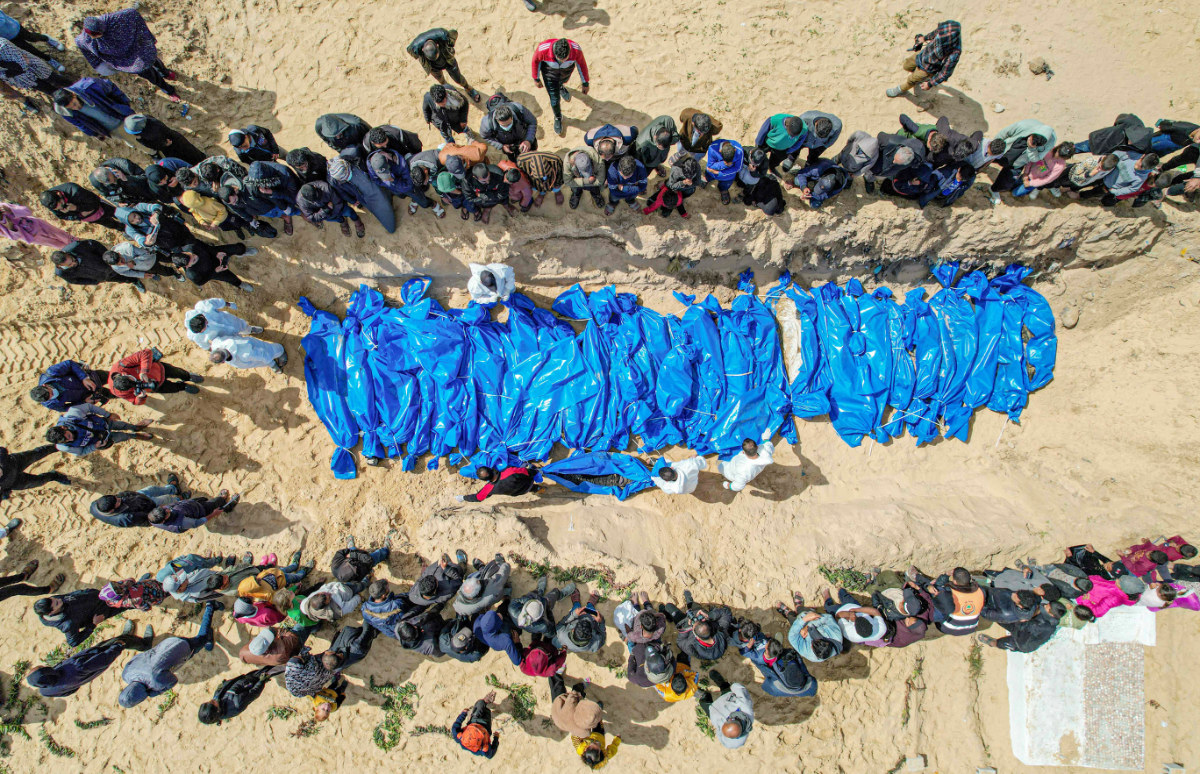TEL AVIV: Shouting “Elections now!” and “Bring back the hostages now!,” thousands of Israeli demonstrators gathered in Tel Aviv Saturday to demand the departure of Prime Minister Benjamin Netanyahu after five months of war in Gaza.
With t-shirts and banners featuring the names and pictures of hostages seized during Hamas’s October 7 attack, the crowd demanded swift action to rescue the remaining captives.
The attack on southern Israel that triggered the war resulted in the deaths of about 1,160 people, mostly civilians, according to an AFP tally of Israeli figures.

An aerial view shows mourners watching as medical personnel prepare the bodies of 47 Palestinians, that were taken and later released by Israel, during a mass funeral in Rafah in the southern Gaza Strip on March 7, 2024, amid ongoing battles between Israel and the militant group Hamas. (AFP)
Israel’s retaliatory campaign to destroy Hamas has killed 30,960 people in Gaza, most of them women and children, according to the Hamas-ruled territory’s health ministry.
Around 100 hostages remain in Gaza alive and 31 are presumed dead, Israel has said, a key source of demonstrators’ despair.
“We are a broken country,” said Ora, a psychologist in her 60s who did not want to give her full name.
Some protesters called for an immediate ceasefire, a position Netanyahu’s government has so far rejected, arguing it would amount to a victory for Hamas.
“Ceasefire? yes, we don’t have any choice,” said Israel Alva, a former soldier who now sells medical equipment, adding that there was no “political plan” for after the war.
Mediators have been pushing for a new truce deal before the Muslim fasting month of Ramadan, set to begin in the coming days.
But US President Joe Biden said on Friday that a breakthrough was “looking tough.”
Shai Gill, a 50-year-old airline pilot who joined the Tel Aviv rally, said Netanyahu’s government — already hit by a massive protest wave before the war — “cannot stay in power” after the October 7 attack.
“They don’t have the trust of the people and we have to go for an election,” Gill said.
He accused the government of being “driven by the motivation to stay in power, and not by what is good for the country. They just are clinging to their seats.”
Police later said they arrested 16 protesters for public disturbances, while the force used water canons to disperse the crowd as they blocked a highway.
Saturday’s gathering bore some resemblance to mass protests against Netanyahu’s controversial legal overhaul before the war in Gaza — “a century ago,” as one protester put it with a sigh.
Israel’s top court in January ruled against a key component of the changes, which have largely been shelved.
Netanyahu had argued that they were necessary to rebalance powers between judges and elected officials.
But his detractors warned the multi-pronged package could have paved the way for authoritarian rule and be used by Netanyahu to quash possible corruption convictions against him.
Netanyahu was dealt a new blow this week when a probe found that the premier “bears personal responsibility” for a 2021 stampede in northern Israel that killed 45 Jewish pilgrims.
Netanyahu’s Likud party said in response that the investigation was politically motivated.
“Netanyahu has always governed the same way, with this attitude of ‘I’m not responsible’,” Gill said.































